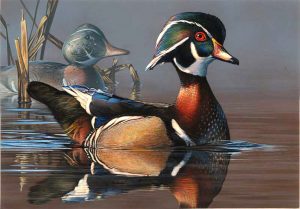 (by Chris Maynard) Chris Maynard saw last month’s Echo article on the 2019 duck stamp and wanted to share this article he wrote about the 2019 contest:
(by Chris Maynard) Chris Maynard saw last month’s Echo article on the 2019 duck stamp and wanted to share this article he wrote about the 2019 contest:
I was asked to be one of the five judges for the 2019-2020 federal duck stamp contest. It is the only art contest sponsored by the federal government and the process is written into federal law. The duck stamp contest began in the 1930s. Hunters have to purchase a stamp in order to hunt waterfowl and the funding goes toward conservation of waterfowl habitat which is how mush of the federal wildlife refuges around the nation have been purchased. It has been quite a success so the managers of the US Fish and Wildlife Service who administer the program came out to Las Vegas for the judging event, including the newly appointed director.
The event was held art Desert Springs, the place where the first European settlers first came in the 1800s. Five judges are different every year as are the mix of judges. This year there were two professional artists, an art professor, a waterfowl biologist, and a Washington DC conservation lobbyist. I was told that the year before, two of the judges were stamp collecting experts.
Several hundred entries had to be winnowed down to the winner, plus a second and a third place winner. Since artists pay over $100 to enter the contest, the number of entries was reasonable for the five of us to winnow down in two days using a very specific and directed process. For instance, we were not supposed to consult with each other or have contact with the public during that time. We could not see how each other voted but the public could and it was all televised. After a person showed a painting to each judge, we would hold up our scores from one to five, kind of like at the Olympics. The first round going through this for all the paintings, we took the top 30 to go to the second round. We did it again. Then voted for the third time, picking the winner.
It was a bit stressful because many of the painters put their heart and soul into their paintings, some working on their piece for a year. Plus, the winner stands to make about an average of a million dollars on sales of the original and mostly, of prints and signings. Sometimes there are hard feelings but for the most part, the contestants managed to keep their feeling to themselves.
My favorite part of the show was talking with a US Fish and Wildlife biologist whose summer job is to count waterfowl from a hundred and fifty feet in the air as he flies back and forth over much of northern Canada from Churchill in Manitoba up and beyond the Beaufort Sea. He also as a sideline counts the muskox and polar bears. We poured over maps of this vast wilderness. I said I wanted to go!
Here is the link to the pictures: 2018 Federal Duck Stamp Art Contest
More information about Chris Maynard







